The Most Venomous Snake in the U.S. (With Bite Facts and Pictures)
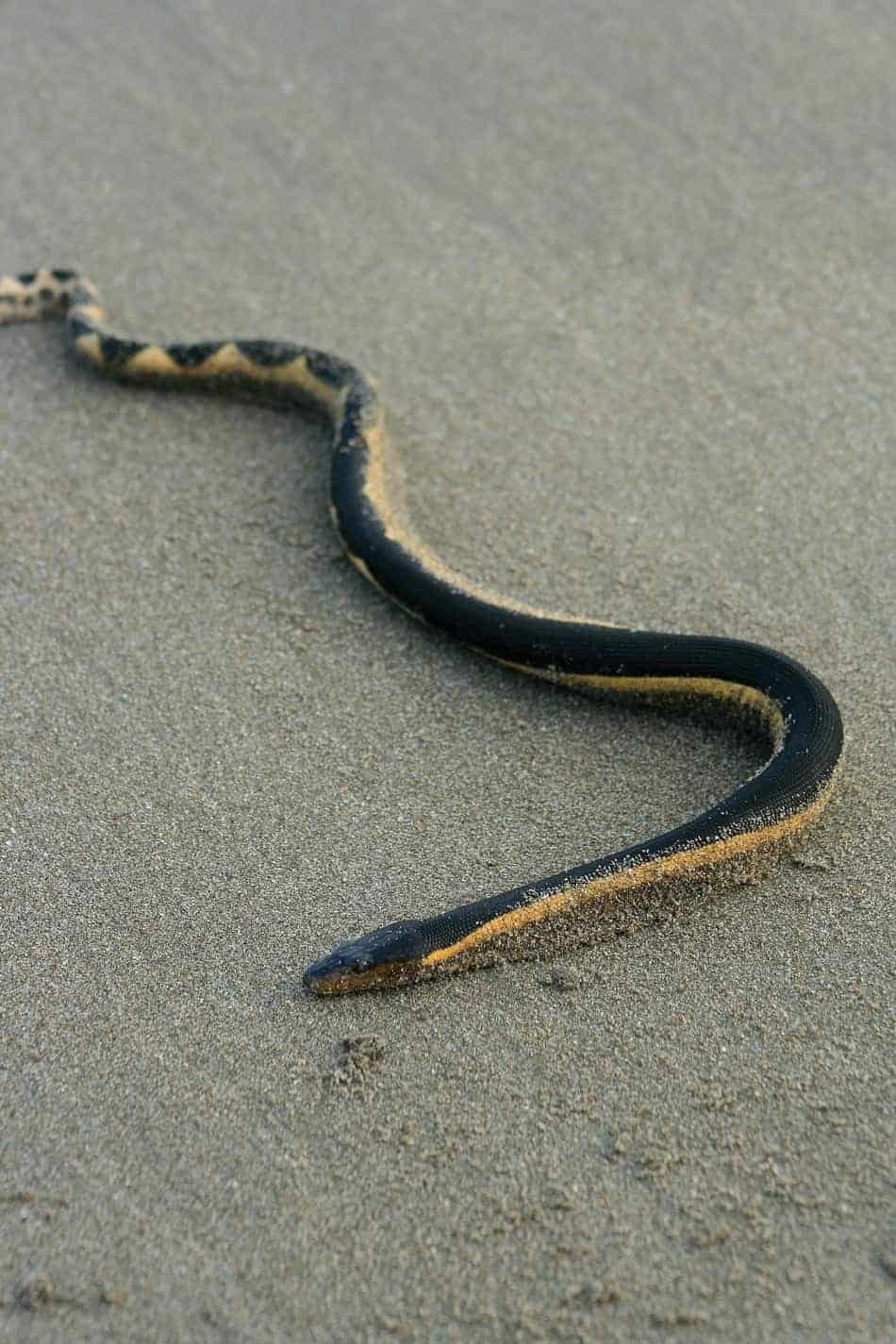
There are a lot of venomous snakes in the United States, but I have always wondered what the most venomous snake in the US was. I really wanted to know the answer, so I did a lot of research and found out some really interesting things.
So, what is the most venomous snake in the United States? The answer is the yellow-bellied sea snake. Their venom is so toxic that just .067 mg can kill a human, and when a yellow-bellied sea snake bites, they release 4 mg of venom.
Learning all of this about yellow-bellied sea snakes made me want to know what the most dangerous snakes were and why, so down below I have a list of the 8 most venomous snakes in the United States of America and how dangerous they are towards humans.
Yellow-bellied Sea Snake
It is so crazy that yellow-bellied sea snakes deliver 60 times the amount of venom it takes to kill a human in just one bite. Even though this snake is highly toxic, it rarely leaves the water, which means it doesn’t have much interaction with humans. Because yellow-bellied sea snake bites are so rare, they actually put this snake towards the bottom of the dangerous
Yellow-bellied sea snakes are actually pretty cool despite their crazy strong ability to kill a human with one bite. These snakes are pretty much completely aquatic and are found in almost all warm tropical waters except the Atlantic ocean. They can be found all the way from Washington state to the bottom of South America.
One of the many incredibly cool things about yellow-bellied sea snakes is their ability to hold their breaths. While swimming, a yellow-bellied sea snake can hold its breath for about 3 hours. 3 hours without air – that’s crazy! These snakes also never have to go on land in their lives if they don’t want to. As long as they come up for air sometimes, they can stay in the water their entire lives with no problems.
These beautiful snakes are about 3 feet long and have quite a unique body. The top half of a yellow-bellied sea snake is either black or a dark bluish-brown color, while the bottom half of the snake is bright yellow. The scales are hexagonal all along the body. The tail of a yellow-bellied sea snake is yellow and flat, to help with swimming, and has either black spots or black stripes on it. The head is large and long with a slightly narrow neck.
Yellow-bellied sea snakes don’t lay eggs. Instead, they give live birth and are pregnant for about five months. They don’t have a lot of babies at a time, just two to six, but these babies are ready to set off hunting on day one and will likely remain in the water for most of their lives.
Because these snakes are made for water, they are capable of swimming forward and backward with an undulating motion. They can also move pretty fast, up to about 1 meter per second, especially when diving. If they are trying to swim fast, they may also swim with their heads out of the water. I’m guessing this is so they don’t have to hold their breath while fleeing for their lives, but maybe they just like seeing the world speed by.
The diet of a yellow-bellied sea snake is primarily fish. The yellow-bellied sea snake normally attacks by floating still on the top of the water and then lunging at fish that swim by.
Apparently, fish are attracted to floating things that lie still. Yellow-bellied sea snakes are known from being able to catch fish that are behind them by using their tails to swim backward until the snake is in its grasp. These odd snakes also can attack by stealthily sneaking up on prey.
Some people do keep this snake in captivity, but it is usually kept apart from other animals, as it will attack any fish and snakes that are in the water. Yep, yellow-bellied sea snakes can be cannibals if other snakes are around.
Most aquatic snakes stay closer to the shore or to coral reefs, but the yellow-bellied sea snakes are commonly found out in the open ocean well away from the seashore. There was a yellow-bellied sea snake found in an inland marsh, which suggests that the species may live in inter-tidal habitats as well.
Sometimes they are found on or near beaches, but this is often after a bad storm when they have been flung out of the sea by the waves. If you do come across one of these snakes on land or in the water, do not pick it up!
First of all, it could bite you (more on that in a minute) and second, yellow-bellied sea snakes can’t maintain proper blood pressure if they are tilted and not supported by water. Picking up a yellow-bellied sea snake could result in both you and the snake dying.
Yellow-bellied Sea Snake Bite and Treatment
Yellow-bellied sea snakes can and do bite, but it is very rare. Their fangs aren’t very long and because of this, they can’t usually bite through any thick materials like wet-suits. They can bite through bare skin though, so be careful around these snakes.
If bitten by a yellow-bellied sea snake, even though it is extremely rare, the bite wouldn’t be painful and there would only be little pinprick marks where its fangs entered. Even if a yellow-bellied sea snake bites, it will rarely release venom. If it does, there are no outward signs because their venom is a neurotoxin. The symptoms of the bite would be internal and would include:
- Painful muscles
- Inability to move legs
- Blurry vision
- Joint aches
- Vomiting
- Excess saliva
- And a thick tongue
If symptoms haven’t occurred within 8 hours, the snake did not release any venom and you are fine.
To take care of a bite from a yellow-bellied sea snake, make sure that you and everyone around stays calm. Panic can cause irrational and dangerous behavior which can cause delays in treatment. Every minute counts when there’s a potential of poison in the bloodstream.
Another important thing to remember is to not tamper with the bite. Don’t rub or massage it, no matter what it feels like around the bite. Don’t try to clean it without proper medical expertise. In some countries, they recommend not even wiping over the bite so that they can test the bite for venom.
You can tie a bandage over the bite if needed, just ensure that the pressure isn’t too much. If the bandage is too tight, it could aggravate the bite or turn the bandage into a tourniquet. Never, no matter what snake it was that bit you, use a tourniquet. Tying a tourniquet on a limb with a snake bite could result in that limb losing circulation completely and having to be amputated as a result.
It is also a poor idea to make a cut near the bite or suck out the venom with your mouth. Avoid putting chemicals or alcohol on the bite as well. These and other various “first aid” measures are actually useless and dangerous to the victim and the person helping the victim.
After you have the bite bandaged, try to keep the limb as still as possible. When you transport the victim to the hospital, do everything possible to prevent undue stress, panic, or movement in the victim.
One more thing to note: don’t bother going out of your way to kill the snake if you or a companion is bitten. However, if you do manage to kill the snake without presenting unnecessary risk to the victim or yourself, take it along to the hospital. It can help the medical staff know the proper treatment. But be careful! Even dead snakes can poison you if you get near their teeth.
Eastern and Western Coral Snakes

I put both the eastern and the western coral snakes together because they have a huge amount of similarities and very few differences, the biggest one being where they live. Both of these snakes have the same coloring pattern of black, red, and yellow stripes with the red and yellow stripes touching. One thing to pay attention to with coral snakes is that, though the black, red, and yellow stripes are the common pattern, they can actually have a lot of other patterns. These two species of snakes made it into this article because both of these snakes contain one of the most neurotoxic venoms in all of the United States.
Coral snakes are small snakes, typically less than two feet long. They are also very thin, even as skinny as a pencil. Despite their small size, these snakes carry some serious venom.
These sibling snakes carry enough venom to kill about 4 full-grown humans, and it only takes around 4-5 mg of their venom to get the job done. Although these snakes are one of the most toxic snakes in North America, they aren’t considered one of the most dangerous.
Why? Well, in order for a coral snake to release enough venom to seriously injure or kill a human, they need to be able to consecutively bite or chew on their chosen prey. Because of this, most humans can get the snake off of them with only receiving a tiny bit of venom if any venom is released at all.
Luckily for humans, coral snakes have a hard time releasing venom, and even luckier is that humans rarely see these toxic snakes. Western coral snakes prefer hiding in dry rocky areas and eastern coral snakes prefer burrowing underground in forested areas. Both snakes are nocturnal and are rarely seen during the day. These facts are very important because there is currently no anti-venom for coral snakes.
These snakes can be kept in captivity, but because there is no antivenom for their bites, extreme caution needs to be taken around these snakes. If you want to know more about coral snakes and their venom, check out this article.
Eastern Diamondback Rattlesnake
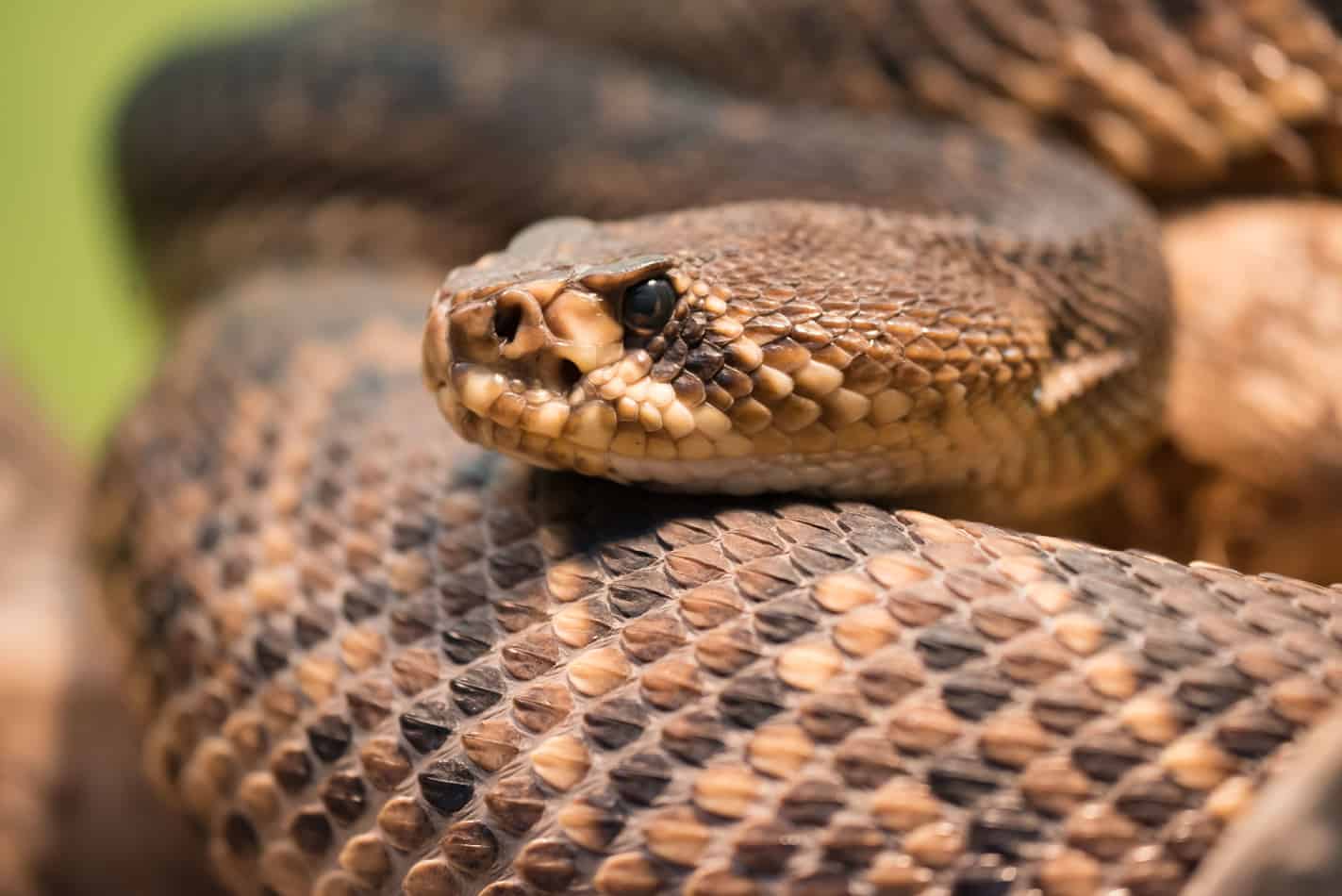
Our dear friend the eastern diamondback rattlesnake is known for being the biggest venomous snake in all of the Americas. It gets this title by growing up to 8 feet long and pushing weights of 35 pounds and sometimes higher. I don’t know about you, but that sounds extremely terrifying to me.
Anyway, this
It only takes 150 mg to become lethal to a human. Luckily for humans though, they don’t always pump that much venom in one bite and we have a very potent anti-venom that, when delivered in massive doses, works quite well.
Despite the useful antivenom, the fatality rate of eastern diamondback rattlesnakes is around 10-20 percent, which makes them one of the United States most dangerous venomous snakes.
Basically, you want to avoid a bite from these as much as possible. It should be acknowledged, however, that the 10-20 percent fatality rate is based on people who do not seek treatment for their bites. If you seek medical attention quickly, the fatality rate is actually less than 1 percent.
Eastern diamondback rattlesnakes can be found primarily in Florida and southeastern parts of the US; usually, they are found in pine forests, mountain, dry marsh, and coastal areas.
Because of these snakes massive size, their warning rattle can normally be heard from a few yards away, but like all other rattlesnakes, the eastern diamondback is known for striking without warning. The strike range of an eastern diamondback rattlesnake can be around 2 feet or more. Needless to say, these snakes have earned their way onto this list.
If you want to know more about these massive venom carriers, read more here.
Western Diamondback Rattlesnake
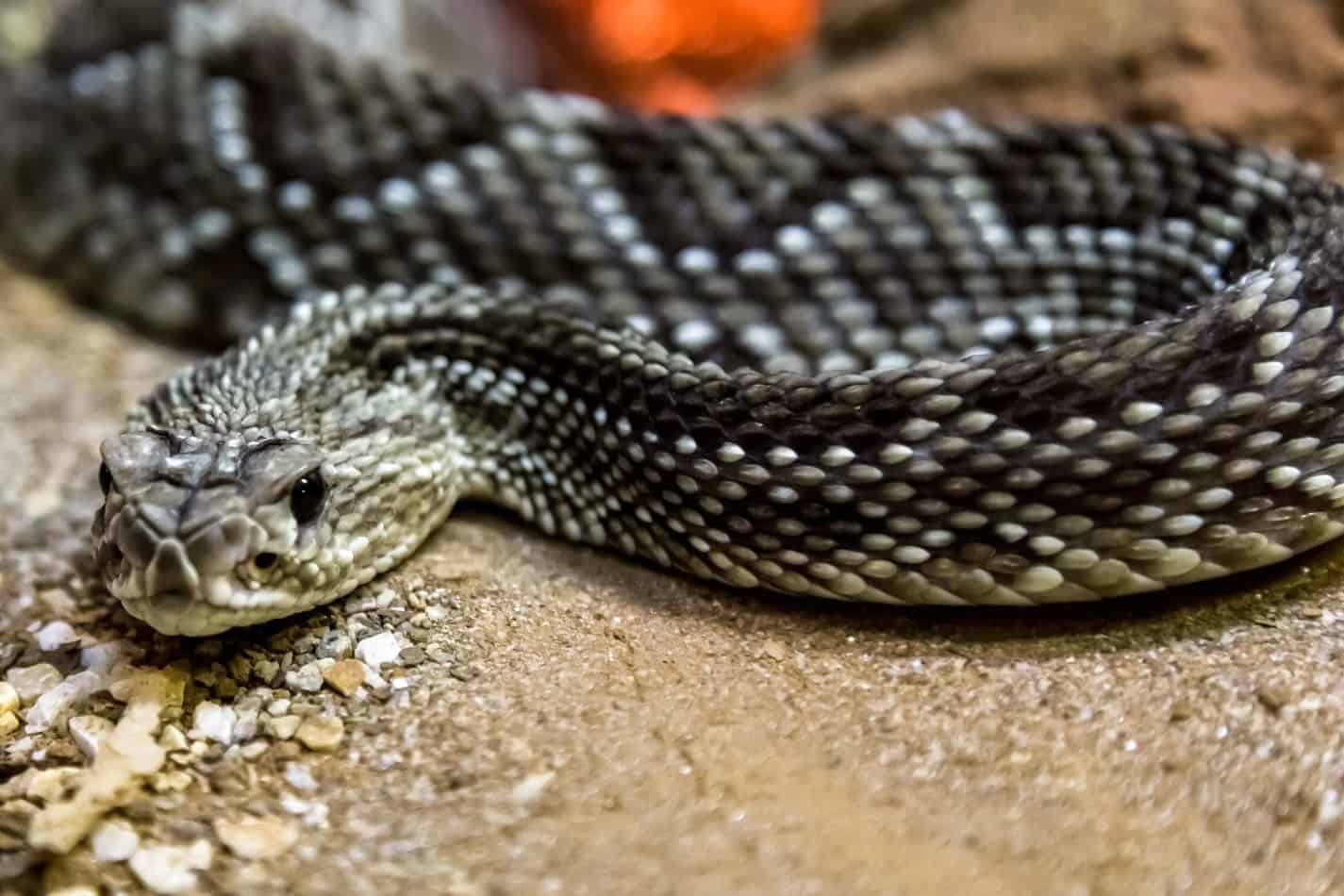
While the western diamondback rattlesnake is not quite as large and intimidating as its relative the eastern diamondback rattlesnake, it too has some very interesting qualities that make it one of the most dangerous venomous snakes in the US.
Western diamondback rattlesnakes have a huge range that stretches all the way down to Mexico and stretches up through California about halfway to Canada. Because these snakes have such a wide range that is sparingly populated, they barely trail their cousins, the eastern diamondback rattlesnakes, in most fatalities caused in the US by snake bites, even though they both have a 20 percent fatality rate.
In Mexico, the western diamondback rattlesnake is the cause of most snakebite fatalities. There are multiple reasons that western diamondback rattlesnakes are so dangerous, and the most common one is its incredible bite.
If a western diamondback rattlesnake delivered a full envenomation during its bite, it would inject 800 mg of venom into its victim. Their venom is not as toxic as other rattlesnakes, but because of their ability to inject so much venom, it causes severe skin deterioration and blood clotting.
The venom of these rattlesnakes contains neurotoxins. This can cause problems with vision, muscle strength, and even breathing. Be aware that, if bitten, you may experience some of these symptoms before you receive medical care. Being aware of these symptoms can help you to stay calm during a crisis.
These 4-5 feet snakes can be quite deadly and need to be taken seriously. They normally like to sunbathe during the day under bushes and can normally be found in sandy sun-warmed deserts, marshes, and the rocky mountains.
Their tendency to hide is an important fact to remember because most of the time when people are bitten by western diamondback rattlesnakes, it is because they accidentally stepped on the snake while out walking. This doesn’t mean you should never go on a hike again. Just keep an eye out for snakes and an ear out for rattles.
Cottonmouth Snake
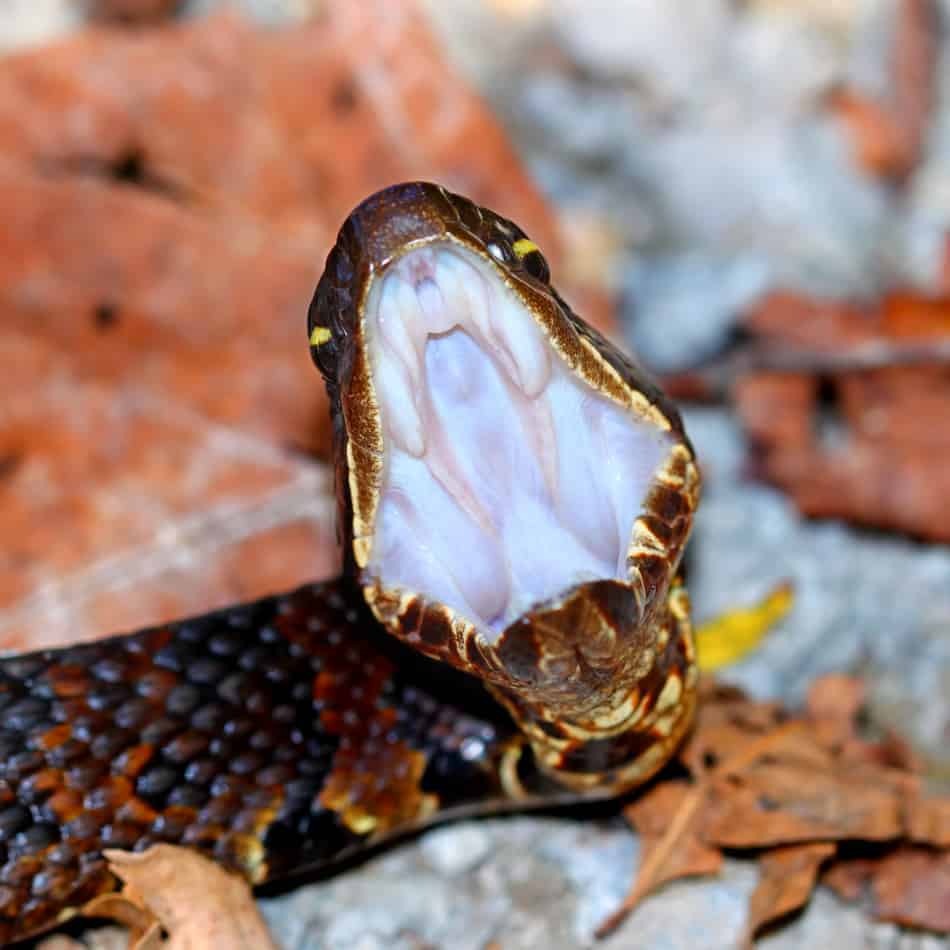
The cottonmouth snake is quite similar to its cousin the copperhead snake, but it is more deadly and has a secret talent. Although cottonmouth snakes are not ridiculously venomous or large, they made it on this list because they are the only semi-aquatic viper in the world.
Cottonmouth snakes can usually be found in swamps, marshes, and warmer streams and lakes. Although, cottonmouths are known for being able to swim in salt water and have colonized some islands of the eastern sea coast.
These crazy swimmers are venomous and although their bites will hurt, their venom is not toxic enough to kill a human. Cottonmouth snakes are great at giving warnings like hissing and opening their mouths super wide to scare away potential predators. Just like their cousins though, the cottonmouth vipers normally only strike when touched.
If you are bitten by a cottonmouth, be prepared to experience swelling. The swelling isn’t limited to around the bite either. It spreads into the limbs and the rest of the body if left unchecked. The swelling will also be accompanied with itching. A lot of itching. Other symptoms include chills, trembling, and fast heart rate. Sometimes paralysis occurs as well, though if the bite is treated, it will go away.
Despite the venom cottonmouth snakes carry, they’re bites rarely cause death in their victims. So the symptoms may be a little scary, but once you have the right treatment, you will be well enough for some well-deserved rest and relaxation.
For more information on these snakes and their bites, follow this link.
Timber Rattlesnake
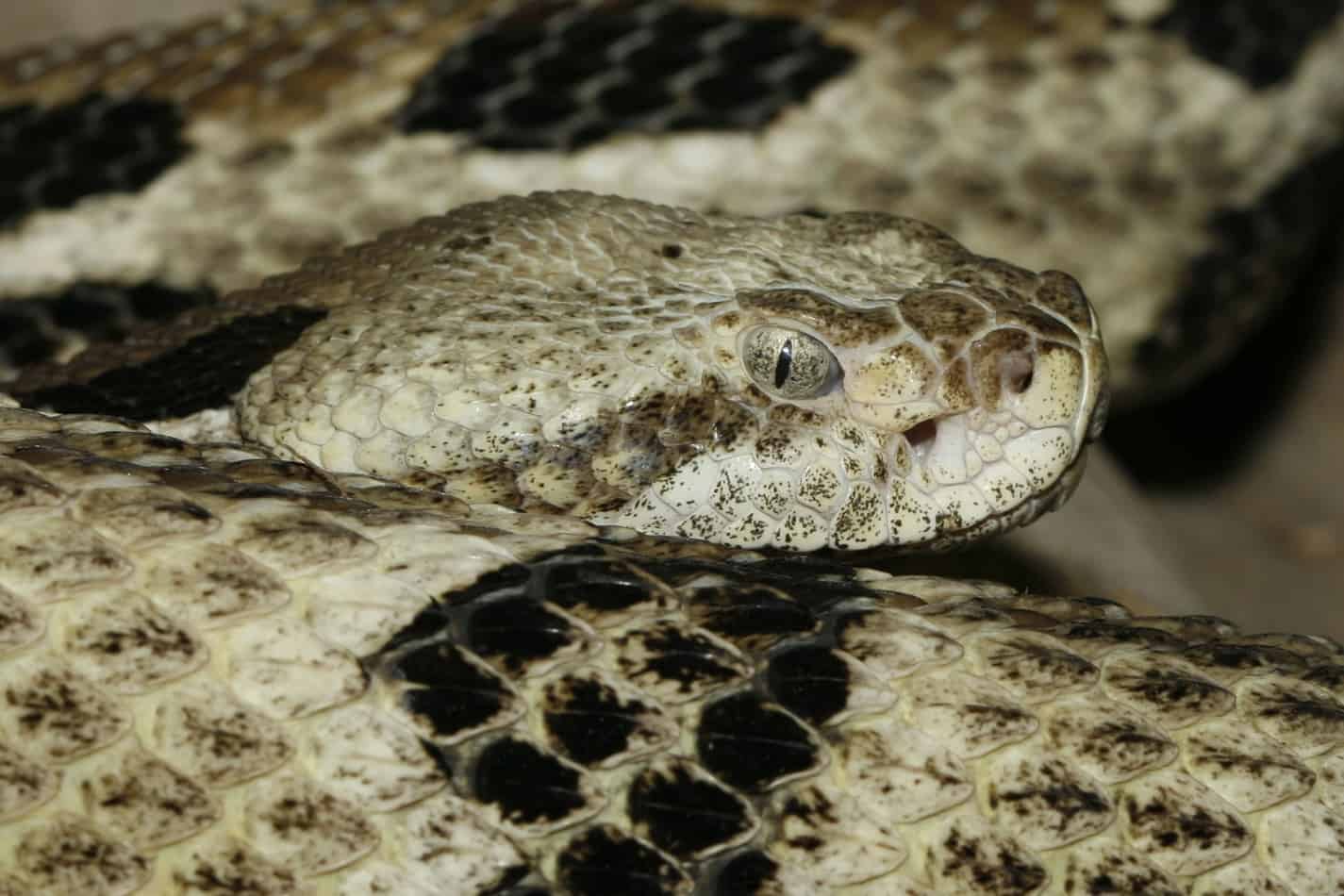
Another rattlesnake joins the pack and for good reason. Timber rattlesnakes are the third most dangerous rattlesnake in not only the United States but in the entire North American continent. They live in the east and go the farthest north of all the rattlesnakes going far into Canada. The venom of Timber rattlesnakes changes based on the regions that they live in.
In the north-east, their venom is hemorrhagic (which damages blood vessels and causes hemorrhaging) while in the south-east, it is neurotoxic (which can cause vision and breathing problems), and in the middle, it is most potent because it has a blend of both venoms.
Timber rattlesnakes can get quite big, being around 6 feet long and weighing around 10 pounds.
These creatures could be more dangerous but they are one of the few rattlesnakes that actually use their rattle to warn predators. They will take up a strong visible posture and rattle loudly for quite a while before biting.
Although they are not particularly aggressive they have made a name for themselves across their regions as a snake that is not meant to be trifled with.
Mojave Rattlesnake

Mojave rattlesnakes are not very big but they do pack quite the punch. These snakes are spread over the southwest region of the United States and down into Mexico. They are named after the Mojave desert in California but are also found in Arizona, New Mexico, Texas, Utah, Nevada, and of course down throughout Mexico.
These little guys love the hot temperatures and expect their climates to remain warm. Mojave rattlesnakes are normally found within 500-5000 feet in elevation and love desert flats. They don’t normally like rocky canon type areas and as such are not normally found there.
Unlike most vipers and rattlesnakes, the Mojave rattlesnake’s venom is a highly potent neurotoxin with
Mojave rattlesnake bites are considered to be some of the worst because they cause relatively no pain, and the common side effects can take up to 24 hours to set in. That’s why it is so important to go to the doctor and receive treatments of the anti-venom as soon as possible. By the time you feel the symptoms set in, the venom could have spread widely through your body.
The most popular anti-venom in the United States is based on the venom of the Mojave rattlesnake.
Find out more about these fancy patterned rattlers here.
Massasauga Rattlesnake
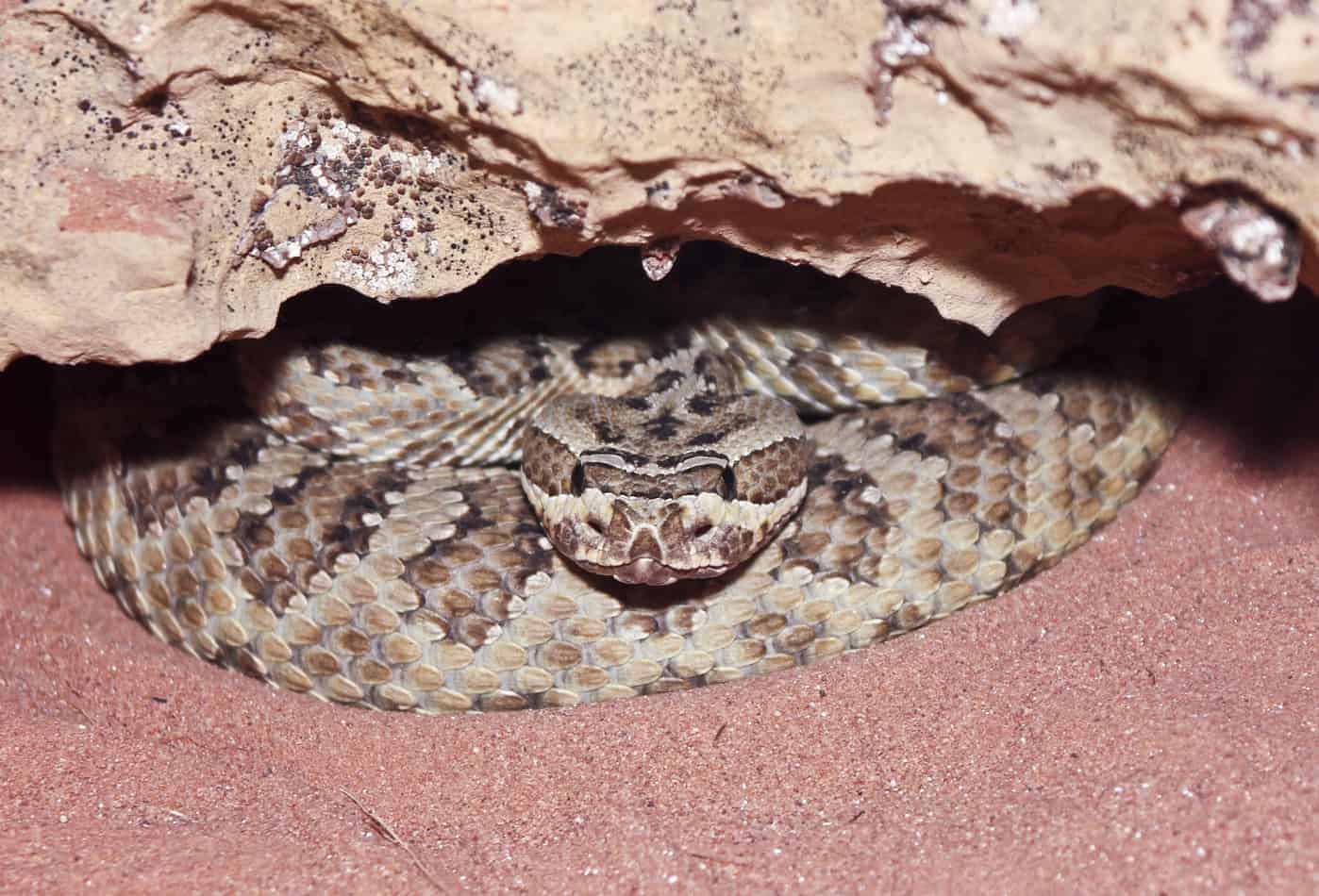
The massasauga rattlesnake is the last of our venomous list and is one that doesn’t often make the most venomous list, but because this list is combining venom and danger, the massasauga rattlesnake has made it. This rattlesnake is very small for a rattlesnake, with typical adults only reaching about 24 inches long. These rattlesnakes survive mostly on frogs, which is rather uncommon for rattlesnakes, and lizards.
Another uncommon trait that the massasauga rattlesnake has, and the main reason that it is making the list, is that there is no anti-venom for their bites. Doctors normally will use a general anti-venom and luckily it seems to work well. But there have been cases across the decades of untreated bites that have killed humans.
So, we added the massasauga rattlesnake to prove that even the smallest rattlers can pack a big bite and all venomous snake bites need to be taken seriously and taken to the hospital.
Their venom also carries unique enzymes. These enzymes prevent blood from clotting, which means that you will likely keep bleeding until you are treated. The bites are small, so it might not be a lot of blood, but don’t expect it to stop quickly. It could also cause problems with bleeding in other places in your body.
Again, treatment for these bites is essential. There are only two recorded deaths by massasauga rattlesnakes, and those deaths occurred because the people didn’t seek treatment.
Massasauga rattlesnakes do have smaller fangs than most rattlesnakes because of their smaller size. Because of this, they often can’t bite through clothes or deliver large amounts of venom. That doesn’t mean their bites shouldn’t be taken seriously, but it is possible that if they attempt to bite you, they might not succeed in doing so.
Related Questions
What are the most venomous snakes in the world? There are quite a few venomous snakes in the world and one could go on and on listing these snakes and their dangers, but here are the top five snakes that are quite bad and need major attention for.
- The Blecher’s Sea Snake. Their venom is 100 times more toxic than all other snakes.
- The Inland Taipan is known for how fast it bites.
- The Philippine Cobra. This cobra possesses the most toxic venom of all Cobras.
- The Death Adder lives up to its name.
- The Eastern Brown Snake is considered the worlds 2nd most venomous snake.
How do you get treated for a snake bite? If bit by a snake, note the appearance of the snake and then move out of striking distance. Call for emergency help if in range or drive to a hospital. If waiting for emergency help lay down with the area that was bitten below the heart. Be calm and cover the wound before removing any shoes or jewelry that may cause extra damage.
What is the difference between poison and venom? Poisons work through touch, inhalation, or ingestion. Venom, on the other hand, has to be injected and is normally injected into a wound because of a bite.
